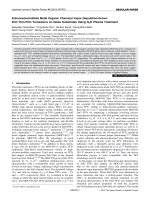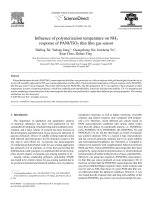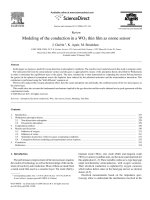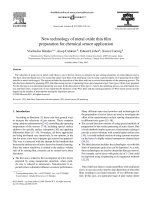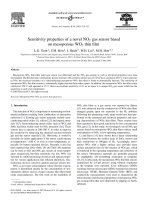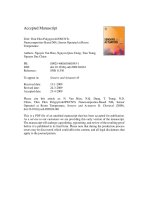Epitaxial-like growthof solution-processed PbZr0.4Ti0.6O3 thin film on single-crystal Nb-doped SrTiO3 substrate
Bạn đang xem bản rút gọn của tài liệu. Xem và tải ngay bản đầy đủ của tài liệu tại đây (1.03 MB, 20 trang )
<span class='text_page_counter'>(1)</span><div class='page_container' data-page=1>
<b>Epitaxial-like growth of solution-processed PbZr0.4Ti0.6O3 thin film on </b>
<b>single-crystal Nb-doped SrTiO3 substrate</b>
Hoang Ha1,2<sub> and Bui Nguyen Quoc Trinh</sub>2*
1<sub> Kwansei Gakuin University, School of Science and Technology, Department of Physics, </sub>
2-1 Gakuen, Sanda, Hyogo 669-1337, Japan
2 <sub>Vietnam National University, VNU University of Engineering and Technology, Faculty of</sub>
Engineering Physics and Nanotechnology, 144 Xuan Thuy, Cau Giay, Hanoi, Vietnam
<b>Abstract: PbZr0.4Ti0.6O3 (PZT) thin films have been conventionally fabricated on traditional</b>
silicon substrates with a platinum bottom electrode; however, as a consequence of unit cell
mismatch, the films are difficult to form as an epitaxial-like growth. Hence, PZT films
deposited on single-crystal niobium doped SrTiO3(111) substrates (Nb:STO) are promising to
solve this issue thanks to the similar perovskite structure between PZT and STO. Essentially,
Nb:STO material is a conductor, playing a part in both bottom electrode and epitaxial
substrate. In this work, 200-nm-thick PZT films were successfully fabricated on Nb:STO
substrates by a solution process. One obtained that PZT(111) peak started to appear on the
Nb:STO substrate at a low annealing temperature of 450o<sub>C. Also, scanning electron</sub>
microscopy observation shows smooth and homogeneous surface of PZT films on Nb:STO
substrate with no grain boundary, which evidences for epitaxial-like growth of PZT thin
<i>films. Remnant polarization of 6 µC/cm</i>2<sub> and leakage current of 8×10</sub>-8<sub> A were obtained at</sub>
applied voltage of 5 V.
<b>Keywords: PZT, Nb:STO, spin-coating, ferroelectric, FeRAM</b>
</div>
<span class='text_page_counter'>(2)</span><div class='page_container' data-page=2>
<b>1. Introduction</b>
</div>
<span class='text_page_counter'>(3)</span><div class='page_container' data-page=3>
STO is quite alike with PZT, ensuring the growth of PZT thin film [13]. It has been reported
that PZT(111) would be formed on Nb:STO(111) while it is PZT(001) for Nb:STO(100)
because of a small mismatch unit cells [14-16]. Alternatively, sol-gel processing is
well-suited for depositing high-quality PZT films with good chemical homogeneity, simple and
short-time fabrication, easy to control, and less affected by other factors [17-20]. Thus,
fabrication of PZT thin film on Nb:STO(111) substrate by using solution process and
investigating on their characteristics are studied.
<b>2. Experimental Procedures</b>
</div>
<span class='text_page_counter'>(4)</span><div class='page_container' data-page=4>
<i>Jeol JFC-1200). The ferroelectric hysteresis loops (P-E) and the leakage current characteristic</i>
<i>(I-t) were characterized by using radiant precision LC10 system.</i>
<b>3. Results and discussion</b>
<i>a. Pt/PZT/Pt/TiO2/SiO2/Si ferroelectric capacitor</i>
According to a recent report [21], PZT(111) thin film showed the best crystallization at
600o<sub>C; hence, for a reference of polycrystalline PZT thin film, the sample was annealed</sub>
around this optimum temperature. Figure 1(a) shows the X-ray diffraction pattern of PZT thin
film deposited on Pt/TiO2/SiO2/Si substrate annealed at 600o<sub>C. It describes that many</sub>
<i>different PZT picks grew such as (100), (110), (111), (200), (210), (211), (022) at 2ϴ = 22,</i>
31, 38, 51, 56, and 65o<sub>, respectively. However, [111]-oriented PZT, which improves the</sub>
stability of PZT film, was a weak intensity. As a consequence, PZT deposited on
Nb:STO(111) substrate promises to enhance the diffraction intensity of PZT(111), which will
be discussed later. Figure 1(b) illustrates the surface morphology of PZT thin film via SEM
image. It is obvious that PZT thin film was formed uniformly with sharp boundary, the
biggest crystal size was about 200 nm while the smallest one was approximately 50 nm. Both
of the results above imply the PZT thin film formed in a polycrystalline structure.
After dot-shaped Pt bottom electrodes were formed, the ferroelectric property and the leakage
current were studied as shown in Fig. 1(c) and (d), respectively. A wide range of electric field
from 50 to 250 kV/cm was applied on ferroelectric capacitor, as a result, the spontaneous
<i>polarization (PS) was nearly 45 µC/cm</i>2<i><sub>, the remanent polarization (PR) was approximately 35</sub></i>
</div>
<span class='text_page_counter'>(5)</span><div class='page_container' data-page=5>
investigation on the leakage current characteristic when the voltage applied is essential to
evaluate the insulating quality. In principle, the leakage current characteristic is divided into
three regions, depending on the voltage amplitude. The first region depends on voltage by a
linear relationship, and follows Ohm’s law. The second one is known as the contribution of
discharge current, proposed by Pool – Frankel and Schottky. The third one relates to the
insulator-breakdown effect or the Fowler – Nordheim tunneling effect. Importantly, the
leakage current characteristics provide the energy consumption of the electronic device in
<i>stand-by status or not in use. Therefore, apart from the investigation on the P-E loops, the I-t</i>
of PZT thin film was measured for each polarization voltage, as shown in Fig. 1(d). At a low
applied voltage of 1 V, the leakage current was approximately 10-6<sub> A while it had a</sub>
significant increased trend and reached to 5×10-5<sub> A at 5 V. Therefore, it should be improved</sub>
to reduce the energy consumption of devices.
<i>b. Pt/PZT/Nb:STO(111) ferroelectric capacitor</i>
</div>
<span class='text_page_counter'>(6)</span><div class='page_container' data-page=6>
although PZT(111) peak increased dramatically comparing to the M450, the unknown peak at
36o<sub> still existed. The temperature of 500</sub>o<sub>C would be not enough to change completely from</sub>
pyrochlore phase to crystal or destroy this structure. Therefore, raising the annealing
temperature could improve not only diffraction intensity of PZT(111) but also electric
properties of thin films. For the M550 and M600, PZT(111) peak enhanced obviously, and
the detector did not find any unknown peak. According to other works, this consequence
resulted from the small mismatch between PZT and Nb:STO(111) substrate, for instance,
Nashimoto and co-workers showed that this was 7.5 and 11.4 ppm/o<sub>C for PZT and Nb:STO,</sub>
respectively [7]. Moreover, PZT and Nb:STO(111) crystals are perovskite structure, the
lattice constant of PZT(001) was around 4.052 Å while that of STO(100) was approximately
3.905 Å; and the lattice constant of PZT(111) was nearly 5.717 Å while that of STO(111)
was about 5.523 Å [14]. That is, Nb:STO(111) played a role in forming PZT(111) regardless
the ratio Zr/Ti was changed from 40/60 to 60/40 [24].
The surface morphology of PZT thin films deposited on Nb:STO(111) was illustrated on Fig.
3. From SEM images, it is clear that the surface of thin films was smooth and there was no
grain boundary, which was totally comfortable to X-ray diffraction pattern. It means that
epitaxial-like PZT thin films were successfully deposited on Nb:STO(111) substrate. Fig.
4(a) describes the structure of Pt/PZT/Nb:STO(111) ferroelectric capacitor and Fig. 4(b)
illustrates a top view of Pt electrode, which was quite resemble to mask size observed by
optical microscopy.
</div>
<span class='text_page_counter'>(7)</span><div class='page_container' data-page=7>
<i>clearly, for instance, PR of M550 was 4 µC/cm</i>2<i><sub> and that of M600 was 6 µC/cm</sub></i>2<sub> at applied</sub>
voltage of 5V.
<i>The P-E loops of M550 and M600 were unclosed because of the applied pulse voltage. If the</i>
<i>applied voltage is continuous pulses, P-E loops would be close cycles. In this study, since it</i>
<i>was only one pulse voltage, P-E loops would be open. Additionally, P-E loops were</i>
asymmetric because the Pt/PZT/Nb:STO(111) capacitor owns two different materials of
electrodes, i.e., Pt for top electrode and Nb:STO for bottom electrode [25]. It is assumed as a
result of electron traps in the interface when electric field was applied, contributing to the
asymmetry on oxygen vacancy inside the interface [26-28]. To explain the poor ferroelectric
properties of PZT films on Nb:STO compared to Pt/TiO2/SiO2/Si substrate, three models are
considered. Firstly, Szafraniak and co-workers showed that some defects near the surface of
PZT and Nb:STO as mismatch crystal structure would create some moments and change the
polarization [9]. Otherwise, if the Sr2+<sub>, Ti</sub>4+<sub>, Nb</sub>3+<sub> ions diffuse in PZT layer, it could form a</sub>
new structure. According to Remiens, a slight doping in PZT about 2% could improve
<i>ferroelectric properties while heavy doping would fall down the PR and PS [29-31].</i>
Secondly, a top-top measurement method might lead to the short circuit if PZT surface
quality is poor. As a consequence, the applied voltage will also divided on the PZT surface
<i>that makes the P-E loops degraded. Thirdly, this poor ferroelectric property can be</i>
<i>considered based on ferroelectric domain movements, which affect strongly to P-E loops </i>
[31-33].
</div>
<span class='text_page_counter'>(8)</span><div class='page_container' data-page=8>
voltage, clearly for the cases of 4 and 5 V. This is because the equipment did not remove the
remnant polarization of ferroelectric material before each measurement. The remnant
<i>polarization was like a minor power source which contributes the high leakage current at t =</i>
<i>0. Furthermore, in the case of 5 V shown in Fig. 6(a) and (b), the I-t shape was not smooth.</i>
The abnormal peak was contributed from the polarization current of ferroelectric material.
<i>Both the high leakage current phenomenon at t = 0 and the rugged shape of I-t characteristics</i>
were able to neglect when using a technique which decreases steadily the applied voltage to
<i>0, like a sine pulse, in order to neutralize remnant polarization before measuring I-t at each</i>
applied voltage. Therefore, the PZT thin film annealed at 600o<sub>C has the best hysteresis loops</sub>
but not enough great performance to compare with the PZT on Pt/TiO2/SiO2/Si traditional
substrate. However, the leakage current reduced nearly three orders as compared between
Fig. 1(d) and Fig. 6 (c) or (d). In other words, the quality of ferroelectric PZT thin films
should be traded off between remnant polarization and leakage current in order to meet the
requirement of ferroelectric memory or other electronic devices.
<b>Conclusion</b>
</div>
<span class='text_page_counter'>(9)</span><div class='page_container' data-page=9>
<b>Acknowledgment</b>
This research is funded by Vietnam National Foundation for Science and Technology
Development (NAFOSTED) under grant number 103.02-2012.81.
<b>References </b>
1. <i>G.D. Shilpa, K. Sreelakshmi, and M.G. Ananthaprasad, PZT thin film deposition</i>
<i>techniques, properties and its application in ultrasonic MEMS sensors: a review, IOP</i>
Conf. Ser. Mater. Sci. Eng. 149 (2016), 012190.
2. <i>D.H. Minh, N.V. Loi, N.H. Duc, and B.N.Q. Trinh, Low-temperature PZT thin-film</i>
<i>ferroelectric memories fabricated on SiO2/Si and glass substrates, </i>Journal of Science:
Advanced Materials and Devices 1 (2016) 75–79.
3. <i>G. Lu, H. Dong, J. Chen, and J. Cheng, Enhanced dielectric and ferroelectric properties</i>
<i>of PZT thin films derived by an ethylene glycol modified sol-gel method, J. Sol-gel Sci.</i>
Technol. 82 (2017) 530–535.
4. M.V. Silibin, A.A. Dronov, S.A. Gavrilov, V.V. Smirnov, D.A. Kiselev, M.D.
<i>Malinkovich, and Y.N. Parkhomenko, PZT thin films synthesis by sol-gel method and</i>
<i>study of local ferroelectric properties, Ferroelectrics 442 (2013) 95–100</i>
5. <i>C. Luo, G.Z. Cao, and I.Y. Shen, Development of a lead-zirconate-titanate (PZT) </i>
</div>
<span class='text_page_counter'>(10)</span><div class='page_container' data-page=10>
6. K.I. Park, J.H. Son, G.T. Hwang, C.K. Jeong, J. Ryu, M. Koo, I. Choi, S.H. Lee, M.
<i>Byun, Z.L. Wang, and K.J. Lee, High-efficient, flexible piezoelectric PZT thin film</i>
<i>nanogenerator on plastic substrates, Adv. Mater. 16 (2014) 2514–2520.</i>
7. <i>I. Kanno, Piezoelectric MEMS for energy harvesting, J. Phys. Conf. Ser. 660 (2015)</i>
012001.
8. <i>W. Gong, J. F. Li, X. Chu, Z. Gui, and L. Li, Single-crystal Nb-doped Pb(Zr,Ti)O3 thin</i>
<i>films on Nb-doped SrTiO3 wafers with different orientations, Appl. Phys. Lett. 85 (2004)</i>
3818.
9. I. Szafraniak, C. Hamagea, R. Scholz, S. Bhattacgaryya, D. Hesse, and M. Alexe,
<i>Ferroelectric epitaxial nanocrystals obtained by a self-patterning method, Appl. Phys.</i>
Lett. 83 (2003) 2111.
10.<i>K. Nashimoto, D. K. Fork, and G. B. Anderson, Solid phase epitaxial growth of sol‐gel</i>
<i>derived Pb(Zr,Ti)O3 thin films on SrTiO3 and MgO, Appl. Phys. Lett. 66 (1995) 822. </i>
11.W. Li, M. D. Rodriguez, P. Kluth, M. Lang, N. Medvedev, M. Sorokin, J. Zhang, B. Afra,
<i>M. Bender, D. Severin, C. Trautmann, and R. C. Ewing, Effect of doping on the radiation</i>
<i>response of conductive Nb–SrTiO3</i>, Nucl. Instr. And Meth. in Phys. Res. B 302 (2013)
40–47.
12.<i>F. Aguesse, A. Exelsson, P. Reinhard, V. Tileli, J. L. M. Rupp, and N. M. Alford, </i>
<i>High-temperature conductivity evaluation of Nb doped SrTiO3 thin films: Influence of strain</i>
<i>and growth mechanism, Thin Solid Films 539 (2013) 384–390.</i>
13.<i>I. Velaso-Davalos, F. A. Vargas, R. Thomas, and A. Ruediger, Surface preparation of</i>
<i>(110) oriented pure and Nb doped SrTiO3 single crystal substrates by microwave assisted</i>
</div>
<span class='text_page_counter'>(11)</span><div class='page_container' data-page=11>
14.<i>Z. X. Zhu, J. F. Li, F. P. Lai, Y. Zhen, Y. H. Lin, C. W. Nan, L. Li, and J. Li, Phase</i>
<i>structure of epitaxial Pb(Zr,Ti)O3 thin films on Nb-doped SrTiO3 substrates, Appl. Phys.</i>
Lett. 91 (2007) 222910.
15.<i>Y. Luo, X. Li, L. Chang, W. Gao, G. Yuan, J. Yin, and Z. Liu, Upward ferroelectric </i>
<i>self-poling in (001) oriented PbZr0.2Ti0.8O3 epitaxial films with compressive strain, AIP</i>
Advances 3 (2013), 122101.
16.<i>B. He, and Z. Wang, Enhancement of the electrical properties in BaTiO3/PbZr0.52Ti0.48O3</i>
<i>ferroelectric superlattices, ACS Appl. Mater. Interfaces 8 (2016) 6736–6742.</i>
17.<i>Z.-X. Duan, G.-Q. Yu, J.-B. Liu, J. Liu, X.-W. Dong, L. Han, and P.-Y. Jin, Preparation</i>
<i>and characterization of PZT thick film enhanced by ZnO nanowhiskers for MEMS</i>
<i>piezoelectric generators, </i>Progress in Natural Science: Materials International 21 (2011)
159–163.
18.<i>I.Y. Shen, G.Z. Cao, C.-C. Wu, and C.-C. Lee, PZT thin-film meso- and micro devices,</i>
Ferroelectrics 243 (2006) 15–34.
19.<i>A. Shoghi, A. Shakeri, H. Abdizadeh, and M.R. Golobostanfard, Synthesis of crack-free</i>
<i>PZT thin films by sol-gel processing on glass substrate, </i>Procedia Materials Science 11
(2015) 386–390.
20.<i>Y. Liu, K.H. Lam, K.K. Shung, J. Li, and Q. Zhou, Enhanced piezoelectric performance</i>
<i>of composite sol-gel thick films evaluated using piezo response force microscopy, J. Appl.</i>
Phys. 113 (2013) 187205.
21.<i>M. Xiao, S. Li, and Z. Lei, Study of (111)-oriented PZT thin films prepared by a modified</i>
<i>sol-gel method, J. Mater. Sci. Mater. Electron 26 (2015) 4031–4037.</i>
22.<i>M. Khodaei, S.A.S. Ebrahimi, Y.J. Park, S. Song, H.M. Jang, J. Son, and S. Baik, </i>
<i>(111)-oriented Pb(Zr0.52Ti0.48)O3 thin film on Pt(111)/Si substrate using CoFe2O4 nano-seed</i>
</div>
<span class='text_page_counter'>(12)</span><div class='page_container' data-page=12>
23.<i>Q. Yu, J. Li, and W. Sun, Composition-phase structure relationship and </i>
<i>thickness-dependent ferroelectricity of rhombohedral phase in [111]-textured Nb-doped</i>
<i>Pb(Zr,Ti)O3 thin films, Appl. Surf. Sci. 265 (2013) 334–338.</i>
24.<i>N. A. Pertsev, A. K. Tagantsev, and N. Setter, Phase transitions and strain-induced</i>
<i>ferroelectricity in SrTiO3 epitaxial thin films, Physics Revision B 65 (2000) 219901.</i>
25.<i>H. Wen, X. Wang, C. Zhong, Like Shu, and L. Li, Epitaxial growth of sol-gel derived</i>
<i>BiScO3–PbTiO3 thin film on Nb-doped SrTiO3 single crystal substrate, Appl. Phys. Lett.</i>
90 (2007) 202902.
26.G. E. Pike, W. L. Warren, D. Dimos, B. A. Tuttle, R. Ramesh, J. Lee, V. G. Keramidas,
<i>and J. T. Evans, Voltage offsets in (Pb,La)(Zr,Ti)O3 thin films, Appl. Phys. Lett. 66 (1995)</i>
484.
27.<i>D. M. Smyth, Charge motion in ferroelectric thin films, Ferroelectrics 116 (1991) 117.</i>
28.<i>T. Baiatu, R. Waser, and K. H. Hardtl, dc Electrical Degradation of Perovskite-Type</i>
<i>Titanates: III, A Model of the Mechanism, Journal of the American of Ceramic Society 73</i>
(1990) 1663–1673.
29.<i>D. Remiens, E. Cattan, C. Soyer, and T. Haccart, Piezoelectric properties of sputtered</i>
<i>PZT films: influence of structure, microstructure, film thickness (Zr,Ti) ratio and Nb</i>
<i>substitution, Materials Science of Semiconductor Process 5 (2002) 123–127.</i>
30.<i>T. Haccart, D. Remiens, and E. Cattan, Substitution of Nb doping on the structural,</i>
<i>microstructural and electrical properties in PZT films, Thin Solid Films 423 (2003) 235–</i>
243.
31.<i>H. Kuwabara, N. Menou, and H. Funakubo, Strain and in-plane orientation effects on the</i>
<i>ferroelectricity of (111)-oriented tetragonal Pb(Zr0.35Ti0.65)O3 thin films prepared by metal</i>
</div>
<span class='text_page_counter'>(13)</span><div class='page_container' data-page=13>
32.<i>Y. W. Soo, D. J. Kim, T. W. Noh, J. G. Yoon, and T. K, Song, Polarization switching</i>
<i>kinetics of epitaxial Pb (Zr0.4Ti0.6)O3 thin films, Appl. Phys. Lett. 86 (2005) 092905.</i>
33.A. Gruverman, B. J. Rodriguez, C. Dehoff, J. D. Waldrep, A. I. Kingon, R. J. Nemanich,
<i>and J. S. Cross, Direct studies of domain switching dynamics in thin film ferroelectric</i>
</div>
<span class='text_page_counter'>(14)</span><div class='page_container' data-page=14>
<b>Figures caption</b>
<b>Figure 1. PZT thin film deposited on Pt/TiO2/SiO2/Si substrate: (a) X-ray diffraction pattern,</b>
(b) surface morphology, (c) hysteresis loops, and (d) leakage current.
<b>Figure 2. X-ray diffraction patterns of PZT thin films deposited on Nb:STO(111) substrates</b>
at various annealing temperatures.
<b>Figure 3. SEM images of PZT thin films deposited on Nb:STO(111) substrates.</b>
<b>Figure 4. (a) Structure of Pt/PZT/Nb:STO(111) ferroelectric capacitor, and (b) top view of Pt</b>
top electrode.
<i><b>Figure 5. P-E loops of PZT thin films on Nb:STO(111) substrates with various annealing</b></i>
temperatures.
</div>
<span class='text_page_counter'>(15)</span><div class='page_container' data-page=15></div>
<span class='text_page_counter'>(16)</span><div class='page_container' data-page=16></div>
<span class='text_page_counter'>(17)</span><div class='page_container' data-page=17></div>
<span class='text_page_counter'>(18)</span><div class='page_container' data-page=18></div>
<span class='text_page_counter'>(19)</span><div class='page_container' data-page=19></div>
<span class='text_page_counter'>(20)</span><div class='page_container' data-page=20></div>
<!--links-->


